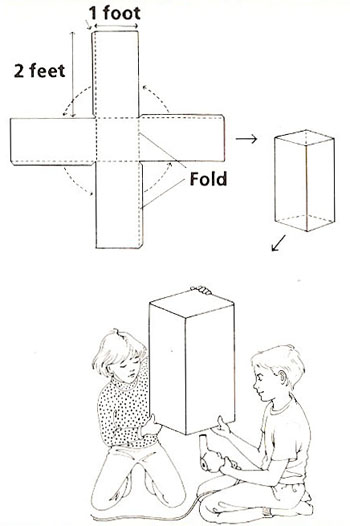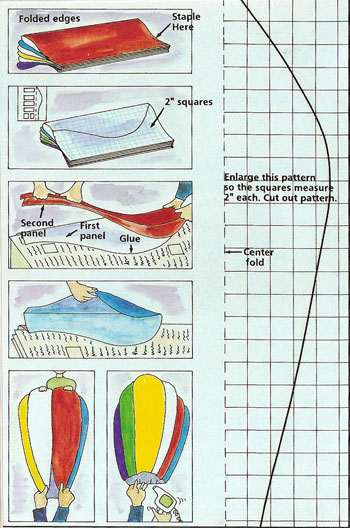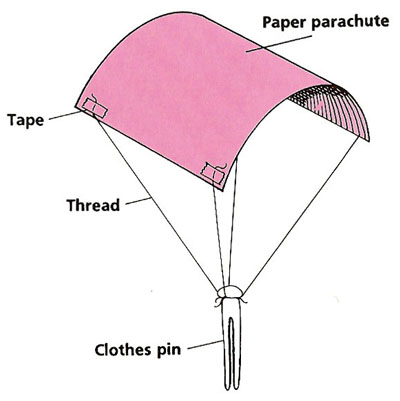UP, UP, AND AWAY: The Science of Flight - 5. Staying Up, Without Really Trying

Figure 1. Hot-air balloons.

Figure 2. Homemade hot-air balloon.

Figure 3. How the shape of a wing, or airfoil, creates lift.

Figure 4. Glider.

Figure 5. Dandelion seeds.

Figure 6. Model parachute.

Figure 7. Parachute.
Airplanes, helicopters, birds, and insects all have to generate a force that is greater than their own weight in order to fly. Yet other objects, such as balloons, seem to be able to stay airborne without any effort.
How is that possible?
Lighter than Air
If an object is lighter than air it will rise, just as something that is lighter than water will float. Helium, for instance, is a gas that is lighter than air. So, if a balloon is filled with helium it will float upward. There has to be enough helium inside so that the combined weight of the trapped gas and the skin of the balloon is less than the weight of an equal volume of surrounding air.
Before World War II, balloons and huge airships known as Zeppelins were often filled with hydrogen, a gas that is even lighter than helium. The problem Is that hydrogen burns violently in air. It takes only the slightest spark to cause a hydrogen balloon to erupt in a great fireball.
Apart from helium, the only gas widely used in balloons today is air itself. Hot air weighs less than cool air. Because of this, if the air inside a large balloon is made warm enough, the balloon will rise.
A typical hot-air balloon has a volume of about 75,000 cubic feet, contains about 2½ tons of air, and can lift equipment and passengers weighing over half a ton. The air is heated by special burners to a temperature of about 100°C (212°F). To fly at a level height, the burners are repeatedly turned on for about five seconds and then off for about 20 seconds.

A lot of hot air
You will need:
What to do: Cut out five sheets of tissue paper according to the measurements given in the diagram. Glue them together as shown. Glue together the long sides to make a rectangular balloon with an opening at the base.
While one or two people hold the balloon upright, use the blow dryer to fill the space inside with hot air. Let go of the balloon. What happens? What happens as soon as the balloon tips over? Try to explain what you observe.
Taking it further: Make a bigger version of the balloon. Fill it with hot air indoors, then launch it outside. How high does it go? Repeat the experiment on different days. Does it make any difference whether it is a warm day or a cold one? Why?
Warning: This experiment should not be attempted without adult help. A blow dryer, like any electrical device, can be dangerous. It should not be used outdoors. It should not be held inside the balloon since this will cause it to overheat.
Experiment in depth:
Making a successful hot-air balloon takes time and patience. The most important thing is that the skin, or "envelope," of the balloon be very light for its size. Try experimenting with both tissue paper and lightweight cellophane to see which works best.
The ideal shape for a balloon is a sphere, because a sphere has the biggest volume for a given surface area. As a result, a perfectly round balloon can hold more hot air for a given weight of envelope material than any other shape.
The trouble is that a round shape is difficult to make from flat pieces. If you wish to attempt it, you will need to cut out 6 panels shaped as in the diagram. Each of the panels should be at least 4 feet high. You will also need a circular panel to close off the top.
The larger the balloon, the greater its lifting power will be, but the more heat it will take to sufficiently warm all of the air inside. A blow dryer should not be used outside because of the danger of electrocution.
By means of a small wire basket hung beneath the opening of the balloon by fine thread, the balloon can be made more steady in flight. This helps to prevent the hot air from escaping (though it adds considerably to the total weight). In addition, a small piece of solid fuel may be placed in the basket and lighted to provide a source of heat in flight. Under no circumstances should this be attempted without the help of a parent or teacher. |
Gliding and Kiting
There is another way an object can remain for long periods off the ground, even if it is heavier than air. This is by using moving currents of air to produce lift.
A glider, for instance, is a plane with very long narrow wings but no engine. It is towed to a height of a few thousand feet by a propeller-driven aircraft (or launched from the ground by catapult). Then it is released. Its wings supply a lot of lift even at low speeds, though not enough lift by themselves to stop the glider from gradually coming down.
To extend the flight, the pilot seeks out "thermals." These are rising currents of warm air that can help carry the glider to a greater height. Many kinds of birds, such as eagles, vultures, and albatrosses, also use thermals to lift them effortlessly high above the land or sea. Notice how the shape of these birds' wings closely resembles those of human-made gliders.
Winds and breezes, too, can enable an unpowered object to fly well. Kites and hang gliders both work by allowing moving air to push against a large piece of stretched material.

Windy travellers
You will need:
What to do: Set up the fan on the table at one end of a large room such as a gymnasium. Turn the fan on to its highest setting. Stand about three feet in front of the fan and drop a seed into the current of air that is blowing out. Follow the seed to find where it lands but make sure that your own movements do not disturb the seed's flight. Make a note of the type of seed, how far it travels from the point of release, and how long it stays in the air.
Repeat this several times for each type of seed. Find the average measurements for that type by dividing the total distance covered and the total time in flight by the number of seeds. Continue the experiment with the next variety of seed.
Which kinds of seeds travel the farthest? What do you notice about the way each type of seed moves? Does it spin or tumble in flight? Does it drop all the time or does it sometimes gain height before falling? By looking at the seeds, try to explain the way they move through the air.
While one or two people hold the balloon upright, use the blow dryer to fill the space inside with hot air. Let go of the balloon. What happens? What happens as soon as the balloon tips over? Try to explain what you observe.
Taking it further: Try making some "seeds" of your own from various lightweight materials such as tissue paper, cotton thread, cellophane, and so on. Can you improve on nature's designs? Which of your human-made seeds travels the farthest? What happens if you sprinkle a little talcum powder in front of the fan? How far do the particles of powder travel?
Experiment in depth: The type of seeds available to you for this experiment will depend on where you live. Use nature books or ask someone who is knowledgeable about local plants to obtain more information.
Note that this experiment does not really recreate the conditions of a windy day outside. The fan provides a single, steady stream of air, the strength of which falls off with increasing distance. In the wild, a seed might be blown continuously over a great distance and be subject to wide variations in wind speed and direction. Can you think of ways to make the experiment closer to "real life"?
One possibility might be actually do the experiment outside on a breezy day. A large open playing field or park would be ideal. While one person releases the seeds from a central point, others might time each seed's flight and measure the distance from the "launch site." Small flags could be pushed into the ground at each landing point, with a different color flag for each type of seed. This would give a very clear picture of the way in which the various seed types were dispersed. |
Riding the Breeze
The seeds of some plants are ideally formed for flying through the air. Some, like the seeds of the maple and sycamore trees, are shaped like tiny helicopter rotors. They spin around as they drop from the branches. This allows them to stay airborne longer so that even the slightest breeze may carry them quite far from the parent tree. Why should this be of value to both the tree and the seed?
The seeds of other plants can stay airborne even longer. Dandelion "clocks," for instance, which resemble miniature parachutes, may be carried over a hundred miles in windy conditions.
The greatest distances of all are covered by tiny specks of matter such as pollen grains and smoke particles. These are so light that they can be lifted thousands of feet above the ground by winds or by warm, rising currents of air.

Model parachutes
You will need:
What to do: Cut out an 8-inch square of paper. Tape four pieces of thread to the corners of the paper and tie or tape the other ends to the object below the parachute. Drop the parachute from a high place such as a chair or side of a staircase. Time how long it takes to reach the ground. Take three measurements and work out the average.
Repeat the experiment with 10", 12", and 14" squares of paper. Plot your results (size of paper versus time to fall) as a graph. From your graph estimate how long you think it would take a 16-inch square parachute to fall, Test your prediction with an experiment.
Taking it further: Repeat the whole experiment using objects of different weight, threads of different length, and parachutes of different shape. Does a circular parachute, for instance, work better than a square one of the same area? What happens if you cut a small hole in the middle of the parachute?
Try using different materials such as cellophane or cotton. Which works best? Try to explain your findings. |
Dropping from the Sky
The "umbrella" part of a parachute traps air as it opens up. The air is squashed so that it has more pushing power (a higher pressure) than the air around. Since it pushes up, it slows down the parachute and its load to a safe landing speed.
Most parachutes are circular. However, parachutes with special shapes, movable panels, or small openings are often used in displays because they can be steered more accurately.
As well as bringing people gently down to earth, parachutes are also used to break the fall of such things as air-dropped food and medical supplies. Three very large parachutes open up on each of the Solid Rocket Boosters (SRBs) after they separate from the space shuttle at a height of 30 miles. This allows the SRBs to splash down safely in the ocean and be recovered for future use.
The most faraway parachute opened up in November 1994 when the Huygens probe descended to the surface of Saturn's mysterious moon Titan.
 |

